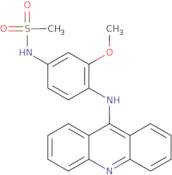Amsacrine
CAS: 51264-14-3
Ref. 3D-BCA26414
| 10mg | Discontinued | ||
| 25mg | Discontinued | ||
| 50mg | Discontinued | ||
| 100mg | Discontinued | ||
| 250mg | Discontinued |
Product Information
- 4'-(9-Acridinylamino)methanesulfon-m-anisidide
- Acridinylanisidide
- Amekrin
- Amerkin
- Amsa
- Amsacrin
- Amsacrina
- Amsalyo
- Amsidil
- Amsidine
- See more synonyms
- Amsidyl
- Ci 880
- Lamasine
- Methanesulfonamide, N-(4-(9-acridinylamino)-3-methoxyphenyl)-
- N-[4-(9-Acridinylamino)-3-methoxyphenyl]methanesulfonamide
- N-[4-(Acridin-9-ylamino)-3-(methyloxy)phenyl]methanesulfonamide
- N-[4-(acridin-9-ylmethyl)-3-methoxyphenyl]methanesulfonamide
- Nsc 156303
- Nsc 249992
- Ph 006888
- Sn 11841
- Sn 21429
- m-AMSA
- m-Amsacrine
Amsacrine is a cytotoxic drug that inhibits the synthesis of DNA by inhibiting the activity of DNA polymerase. It is used in the treatment of leukemia and other cancers. Amsacrine is a potent inducer of topoisomerase II, which can lead to cell death by increasing the number of breaks in DNA. The compound also has been shown to have anti-inflammatory properties, which may be due to its inhibition of prostaglandin synthesis. In vitro assays demonstrated that amsacrine was more active against human cancer cells than against normal cells, while in vivo studies showed that it had little effect on healthy tissues such as liver and kidney. This drug is rapidly hydrolyzed in vivo by α1-acid glycoprotein, with a half-life in serum of about 3 hours. Amsacrine has also been shown to inhibit tumor growth in animal models of squamous carcinoma, but not in lung cancer models.





